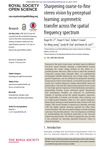Sharpening coarse-to-fine stereo vision by perceptual learning
| dc.contributor.author | Li, Roger W. | en_US |
| dc.contributor.author | Tran, Truyet T. | en_US |
| dc.contributor.author | Craven, Ashley P. | en_US |
| dc.date.accessioned | 2016-10-11T05:37:19Z | |
| dc.date.available | 2016-10-11T05:37:19Z | |
| dc.date.issued | 2016 | en_US |
| dc.identifier.other | HPU4160674 | en_US |
| dc.identifier.uri | https://lib.hpu.edu.vn/handle/123456789/23565 | en_US |
| dc.description.abstract | Neurons in the early visual cortex are finely tuned to different low-level visual features, forming a multi-channel system analysing the visual image formed on the retina in a parallel manner. However, little is known about the potential ‘cross-talk’ among these channels. Here, we systematically investigated whether stereoacuity, over a large range of target spatial frequencies, can be enhanced by perceptual learning. Using narrow-band visual stimuli, we found that practice with coarse (low spatial frequency) targets substantially improves performance, and that the improvement spreads from coarse to fine (high spatial frequency) three-dimensional perception, generalizing broadly across untrained spatial frequencies and orientations. | en_US |
| dc.format.extent | 11 p. | en_US |
| dc.format.mimetype | application/pdf | en_US |
| dc.language.iso | en | en_US |
| dc.subject | Psychology and cognitive neuroscience | en_US |
| dc.subject | Neuroscience | en_US |
| dc.subject | Cognition | en_US |
| dc.subject | Health and disease and epidemiology | en_US |
| dc.subject | Visual plasticity | en_US |
| dc.subject | Stereopsis | en_US |
| dc.subject | Vision enhancement | en_US |
| dc.subject | Generalization | en_US |
| dc.title | Sharpening coarse-to-fine stereo vision by perceptual learning | en_US |
| dc.type | Article | en_US |
| dc.size | 765KB | en_US |
| dc.department | Education | en_US |
Files in this item
This item appears in the following Collection(s)
-
Education [806]

